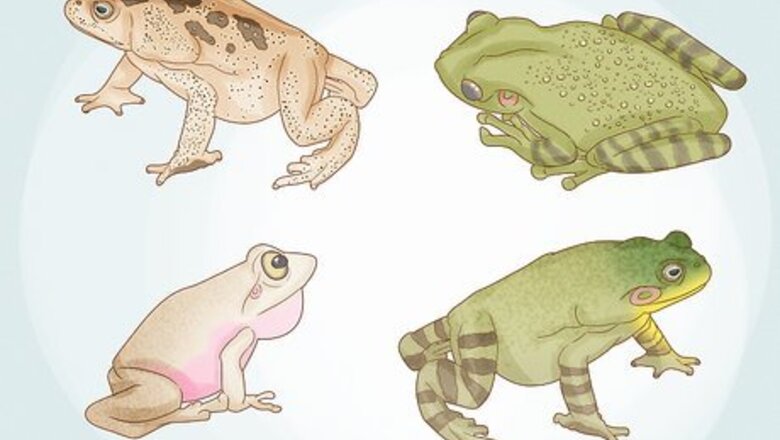
views
- Spray frogs with a mixture of 1.3 lb (600 g) dry citric acid and 1 gal (4 L) of water, or spread salt around the perimeter of your garden to deter them.
- Spray your home or garden with snake repellent or a natural herbicide. Both products also work to keep frogs away.
- Catch the frogs with a net while wearing garden gloves, and release them away from your yard. Also gather tadpoles in the water and lay them in the sun to dry.
Gearing Up to Get Rid of Frogs
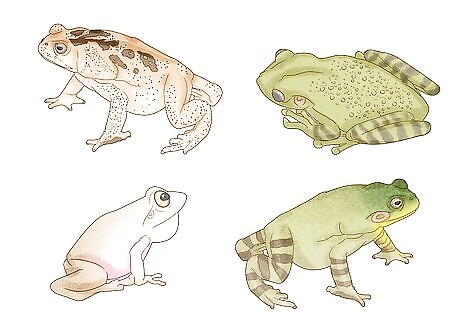
Identify the frog species you're dealing with. Not only will this information help you get rid of the frogs, since different species respond to different methods, but it will also ensure that you're not doing something illegal, as some species of frogs are protected by law. There are some species of frogs that are considered invasive and are legal to kill. These include the following: Bullfrogs outside of their native environment in eastern North America. They compete with native frogs, eat native frogs, and spread chytridiomycosis, an infectious disease that has led to the extinction of 100 frog species. Cane toads outside of their native environment in Central and South America. While not a frog, many people reading this article will be dealing with these amphibians. They are especially rampant in Australia. Cuban tree frogs outside of their native habitat in Cuba. These are a big nuisance in Florida, where they even cause power outages. Coqui frogs outside of their native environment in Puerto Rico.
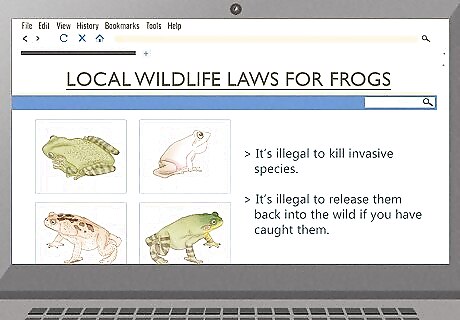
Check the laws in your area. In many parts of the world, it's illegal to kill non-invasive species, but people are encouraged to manage invasive species. Some species are so invasive that it's illegal to release them back into the wild once you've caught them. If you're not sure whether a frog is native or not, take its picture and submit it to the local Fish and Wildlife authorities for identification. Before you take matters into your own hands, you might want to talk to local Fish and Wildlife authorities to discuss the best way to get rid of them in your area.
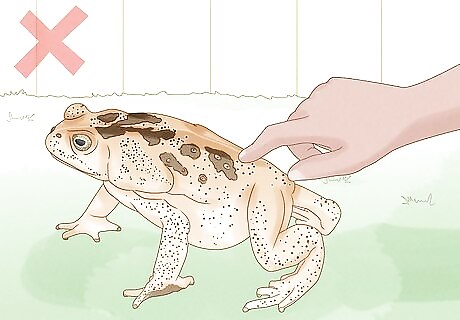
Leave native frogs alone. If you find out that the frogs in your area are native species, you'd do best to leave them alone. Frogs that are native to a certain ecosystem should not be killed, even if they're poisonous. Frogs are vital members of their ecosystems, and in fact their presence is an indication that an ecosystem is healthy. They keep insect populations down and contribute to wetlands in other ways. If you dislike the presence of native frogs, there are still ways to discourage them from coming onto your property. You can keep foliage cut back, for example, so they won't have an enticing place to live. You can also discourage them from coming into the house by keeping it well sealed and screening your windows and doors.
Using Frog Repellants

Introduce natural predators. Snakes and cats both love to eat some types of frogs, so if you introduce some to your property, you'll be able to keep the population down, and your yard will be a lot less attractive to frogs. Before you do this, conduct some research to make sure the type of frog you're dealing with will make a tasty meal for a cat or snake. Remember that many types of frogs are poisonous. Don't try to introduce a predator that would be sensitive to the frogs' poison. Research the predators of the specific frog you're dealing with. Cats and snakes are easiest to introduce, but you might also want to make your yard more hospitable to other predator animals, such as hawks or other birds.
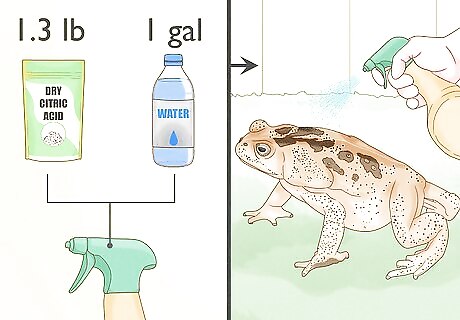
Try natural repellants. There are a few natural substances that effectively kill frogs or repel them from the area. Try using one of these substances before resorting to a chemical spray, since chemical sprays tend to kill the frogs slowly. Organic sprays tend to do the job more quickly and are more humane. Spray the frogs with citric acid. Mix 1.3 lb (600 g) dry citric acid with 1 gallon (4 liters) of water in a large spray bottle. Spray the solution directly on the frogs. It should kill them almost immediately. Spread salt. If you do not have any plants near your pond, spread a little salt around the perimeter. Salt will burn the toes of the frogs, deterring them from the area. Note that salt will destroy plants, however. Spritz the frogs with caffeine. Concentrated caffeine will kill frogs by causing them to have heart attacks, but you can spread coffee grounds around the areas where frogs gather to deter them without killing them off. It will cause the frogs discomfort, but will not likely kill them.
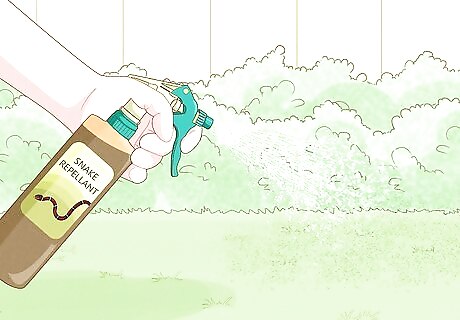
Use chemicals only as a last resort. While there are chemical pest control measures you can take to get rid of the frogs in your yard, these options often torment or kill the frogs slowly and should be avoided unless no other option has proven effective. When possible, use repelling measures rather than lethal ones. Try snake repellent. Spraying snake repellent around the perimeter of your yard is often an effective repellent against frogs. In fact, snake repellent is usually about as effective at getting rid of frogs as it is at getting rid of snakes. Use herbicide. Studies suggest that certain weed killers chemically alter male frogs, stripping away their ability to reproduce. As a result, spraying these herbicides in areas where frogs gather can greatly reduce future frog populations.
Taking Away their Shelter and Food
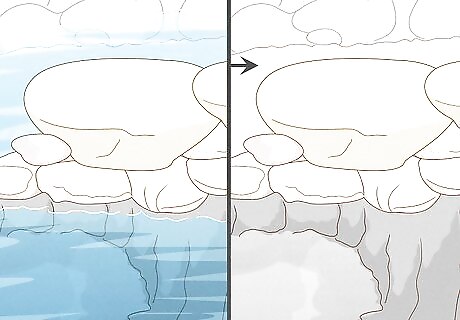
Drain any standing water. Frogs are attracted to moisture, so removing sources of water from your yard will cause most frogs to lose interest and find another place to lay their eggs and shelter at night. You can rent a pump to get rid of most water sources. Birdbaths, swampy areas, bowls of water, and artificial ponds are just a few examples of water sources that attract frogs. Removing sources of stagnant water will also drive away mosquitoes and other insects that frogs feed on, making the area even less appealing. If the water source in your yard is something you want to keep, like a natural pond, try adding a filter or running fountain to your pond. This will cause the water to circulate, thereby eliminating most mosquitoes and other insects. The frogs will still be attracted to the water, but with a decrease in food supply, many may still end up moving on.

Trim your weeds. Tall grass, shrubs, or other bushy plants make the perfect hiding place for frogs. Clearing these elements away forces the frogs to be exposed, which is a condition they generally try to avoid. Having tall plants around a water source is especially troublesome. If you want to maintain tall or bushy plants somewhere in your yard, position them as far away from any water source as possible.
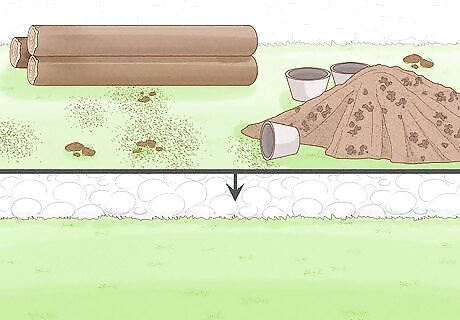
Clear away debris. Like tall grass, clutter in your yard serves as an excellent hiding place for frogs. Removing it will chase many frogs away. Remove empty pots, old lumber, piles of wood chips, or any other structure that may create a damp, dark place for frogs to hide.
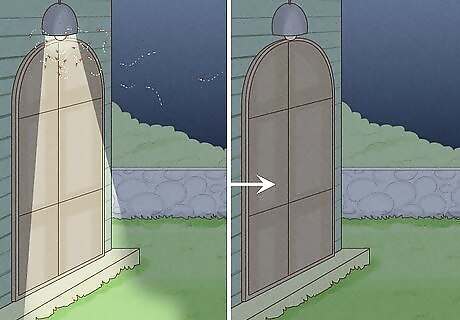
Turn off outside lighting. Light attracts insects, and insects attract frogs. Turning off your outdoor lights at night will reduce both insect and frog populations. Shut off garden lights and porch lights. Close the drapes and curtains in your house to reduce the amount of light filtering out from inside.
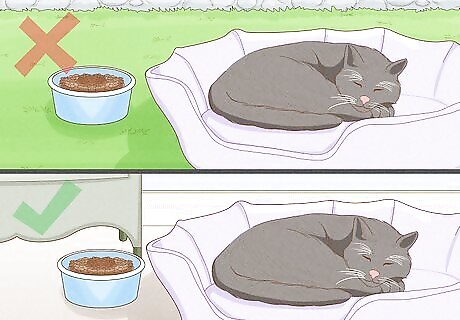
Keep pet food inside the house. While somewhat uncommon, frogs do occasionally steal dog food or cat food. Feed your pets inside or keep the dish inside when the dog or cat is not eating.
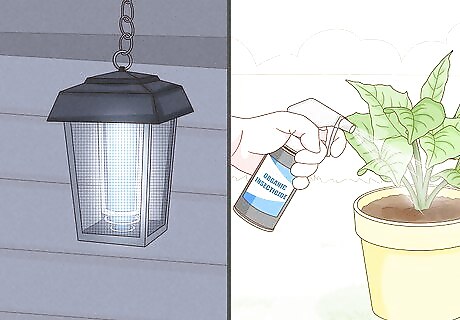
Kill the insects on your property. Since flies, mosquitoes, and other insects are the primary food source for frogs, killing the bugs will deter frogs from coming to your yard. Here are a few ways to control them; Use a bug zapper. Place the bug zapper on your porch to attract and kill all manner of flying insects. Spray organic insecticides. Many chemical insecticides will also kill the frogs, but most organic insecticides do not have that effect.
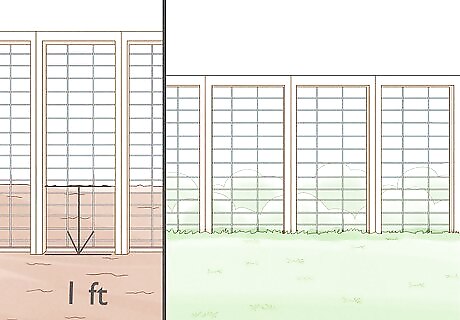
Set up fencing. Surround your property or pond with mesh netting or plastic fencing. Do not use chicken wire or chain-link fencing, since frogs can easily slip through these types of fences. Make sure that the fencing starts at ground level and stands tall. Frogs can leap a considerable height, so a standard-size fence will work better than a purposefully low one. Take precautions to keep the fence stable. Bury the support posts 1 foot (30.5 cm) underground, at minimum, and bury a portion of the fencing material beneath the ground, too.
Physically Removing Frogs

Catch the frogs with a net. Use a butterfly net or another type of long-handled, thinly-meshed net to capture the frogs one by one. If you have an abundance of frogs, you may need to enlist the help of others to accomplish this task. Once you catch the frogs, you have two choices: Relocate the frogs. After catching the frogs, consider relocating them to a nearby pond or stream. When relocating frogs, however, it is important to introduce the frogs to an area that the breed or species can be naturally found in. Otherwise, you can upset the ecological balance of that habitat. Freeze the frogs to death. If it is impossible to relocate the frogs, you can kill them humanely by freezing them. Place the frogs in a sealable container with air holes punched through the lid. Store this container in the refrigerator overnight. The frogs will ease into a coma-like state. The following day, move the container to the freezer and store the frogs there for 48 to 72 hours. Temperatures this cold should kill them.
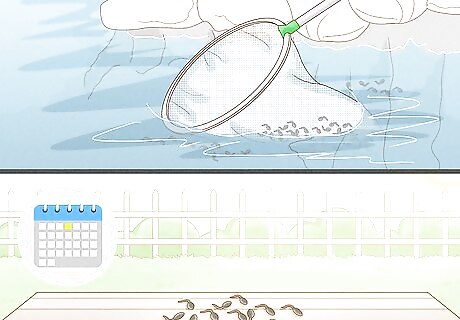
Gather and destroy the tadpoles. Use a standard aquarium fishnet to scoop up any tadpoles in your pond or other water source. Lay the tadpoles out in the sun for a day or so. The dry heat should kill them. You can lay the captured tadpoles out on the cement or lawn, but the drier to surface, the quicker the extermination should be. Alternatively, you could also bury the captured tadpoles underground. This, too, should kill them.
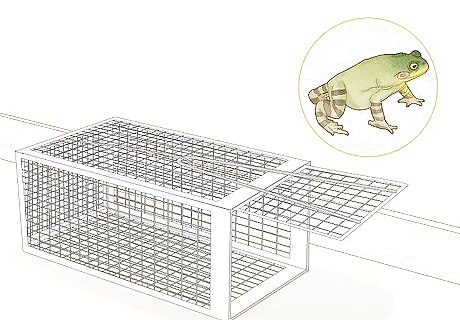
Set traps indoors. If the frogs have found their way indoors, set up standard mouse traps to kill them. Place these traps around any opening that leads from the outside to the inside, such as garage doors, basement windows and vents.
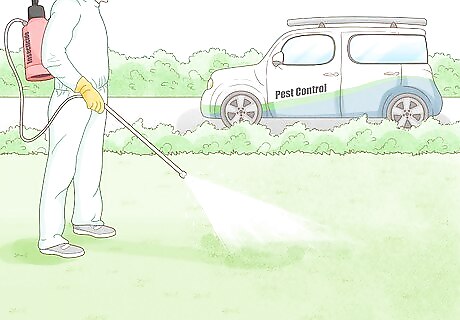
Hire an exterminator. If you are uncertain about how to remove the frogs or are unsuccessful in your efforts, hire a professional.




















Comments
0 comment